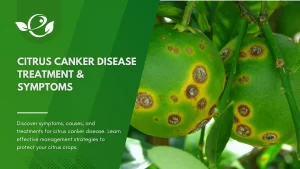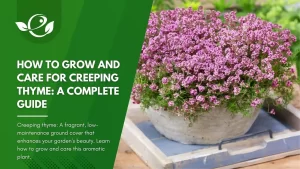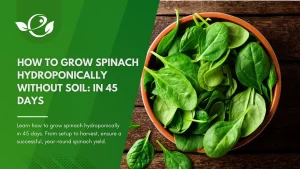Table of Contents
If stubborn weeds are popping up in your garden or cracking through your walkways, you’re not alone. Weeds have a way of sneaking in and stealing the spotlight — along with water, nutrients, and space meant for your prized plants. While chemical herbicides might offer a quick fix, many gardeners are turning to safer, eco-friendly alternatives to protect their soil, pollinators, and pets. Enter vinegar: a common kitchen staple that doubles as a powerful, natural weed killer.
With its sharp acetic acid content, vinegar scorches unwanted plants on contact, making it a go-to option for those looking to control weeds without resorting to harsh chemicals. But before you grab your spray bottle, it’s important to understand how vinegar works, when to use it, and how to apply it effectively for lasting results. In this guide, we’ll walk you through everything you need to know about making and using a DIY vinegar weed killer — so you can reclaim your garden the natural way and keep it thriving season after season.
How Vinegar Weed Killer Works
- Acetic Acid (The Active Desiccant): Acetic acid in vinegar acts as a non-selective contact herbicide, destroying only the foliage it touches by breaking open cell walls and causing rapid desiccation.
- Limitations by Weed Type: Household vinegar (5% acetic acid) is most effective on young, annual weeds with shallow roots, delivering visible browning within hours but often requiring repeat treatments for perennials with deeper systems.
When to Use a Vinegar Weed Killer
A vinegar-based weed killer works best when applied to young, actively growing weeds under hot, dry, and sunny conditions—ideally midday temperatures between 60–90 °F—so that the acetic acid can rapidly desiccate foliage before rain or dew can wash it off. Spraying on wind-free days ensures precise targeting and avoids drift onto desirable plants. Early spring and fall applications often yield the best control of annual and broadleaf perennials, while repeated spot treatments throughout the growing season help manage stubborn or re-emerging weeds

Frequency & Reapplication:
Since household vinegar (5% acetic acid) does not translocate to roots, expect multiple applications per season—typically every 1–3 weeks for problem areas. Horticultural vinegar (20–30% acetic acid) may extend intervals but demands stricter safety gear and cautious use.
DIY Vinegar Weed Killer Recipe
Ingredients
- 1 gallon white vinegar (5% acidity)
- 1 cup salt (enhances desiccation; optional but boosts effectiveness)
- 1 tablespoon dish soap (acts as a surfactant, improving adhesion)
Step-by-Step Instructions
- Mix vinegar and salt in a container until the salt fully dissolves.
- Stir in dish soap gently to avoid sudsing; surfactant helps the solution cling to foliage.
- Pour into a spray bottle or garden sprayer for targeted application.
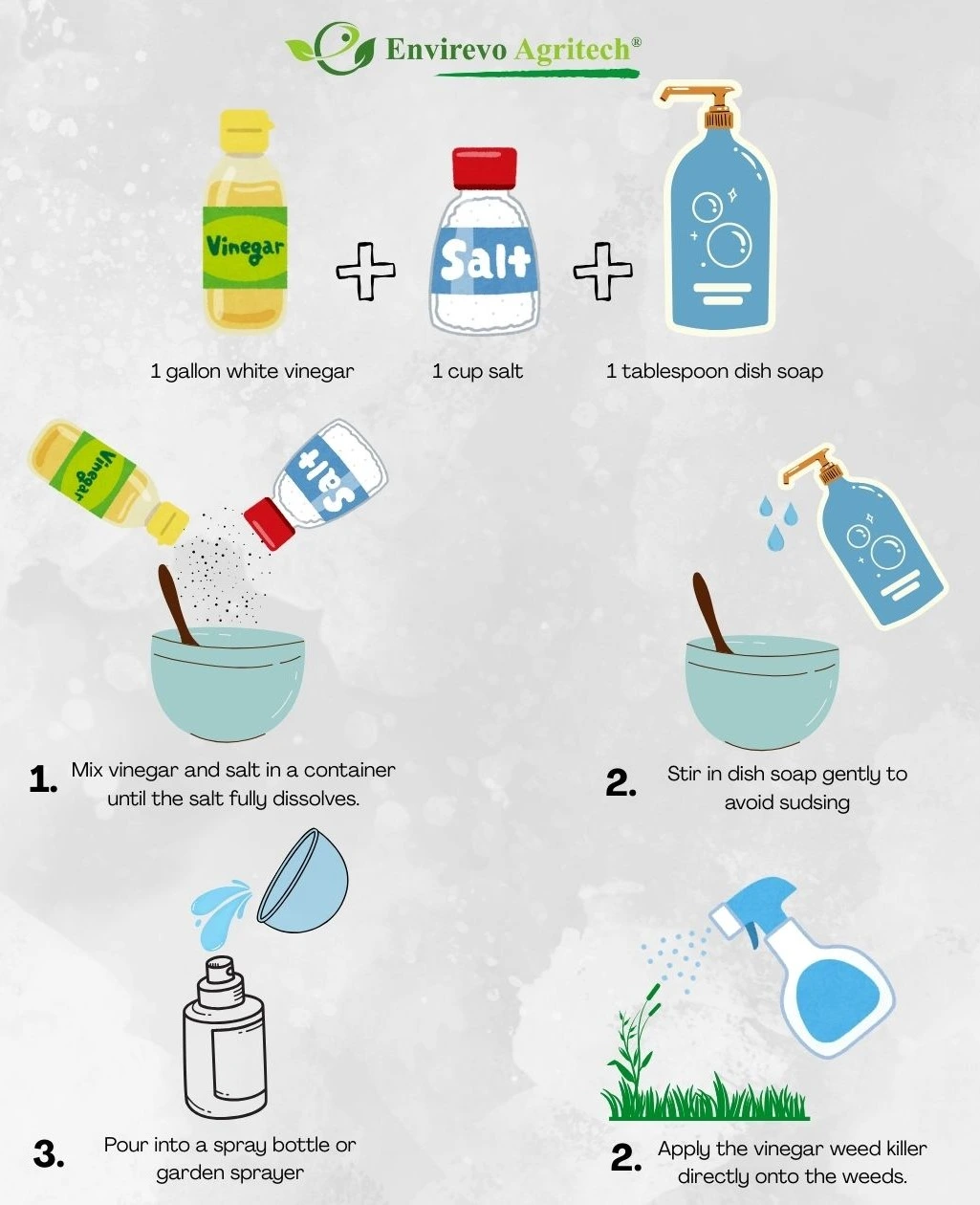
Application Tips of Vinegar Weed Killer for Maximum Effectiveness
Choose the Right Conditions
To get the best results from your vinegar weed killer, timing and technique are everything. Apply on a warm, sunny day when weeds are actively growing and the weather forecast shows no rain for at least 24 hours. Midday, when the sun is strongest, enhances the vinegar’s desiccating power, causing weeds to wither faster. Make sure to thoroughly coat all the leaves until they’re wet but not dripping—this ensures the acetic acid makes full contact with the plant’s surface where it does the most damage.
- Sunny, dry days amplify acetic acid’s burn effect and reduce wash-off risk.
- Temperatures above 70°F help the solution penetrate leaf tissue swiftly.
Targeted Spraying
For younger, tender weeds, a single application can be highly effective. It’s important to remember that vinegar works as a contact herbicide, meaning it kills only the parts it touches; it doesn’t move down to the roots. That’s why persistence is key with tougher, deep-rooted species.
- Direct spray only on weeds, avoiding contact with lawn grass and ornamentals; vinegar will harm any foliage it touches.
- Use cardboard or a board as a shield between weed sprays and desired plants.
Protective Measures
- Wear gloves and eye protection to prevent skin irritation or accidental eye contact.
- Avoid inhalation by keeping a safe distance and spraying downwind.
Pros and Cons of Vinegar Weed Killer
Pros
- Non-toxic when dry, safe around pets and children once foliage has dried.
- Biodegradable: Acetic acid breaks down rapidly in soil, leaving no harmful residues.
- Cost-effective: Made from common household products, under $10 per gallon.
Cons
- Limited root control: Does not translocate to roots, so perennial weeds often regrow.
- Soil pH fluctuation: Frequent applications can temporarily lower soil pH, affecting beneficial microbes.
- Non-selective: Will kill any plant it contacts, requiring precise application.
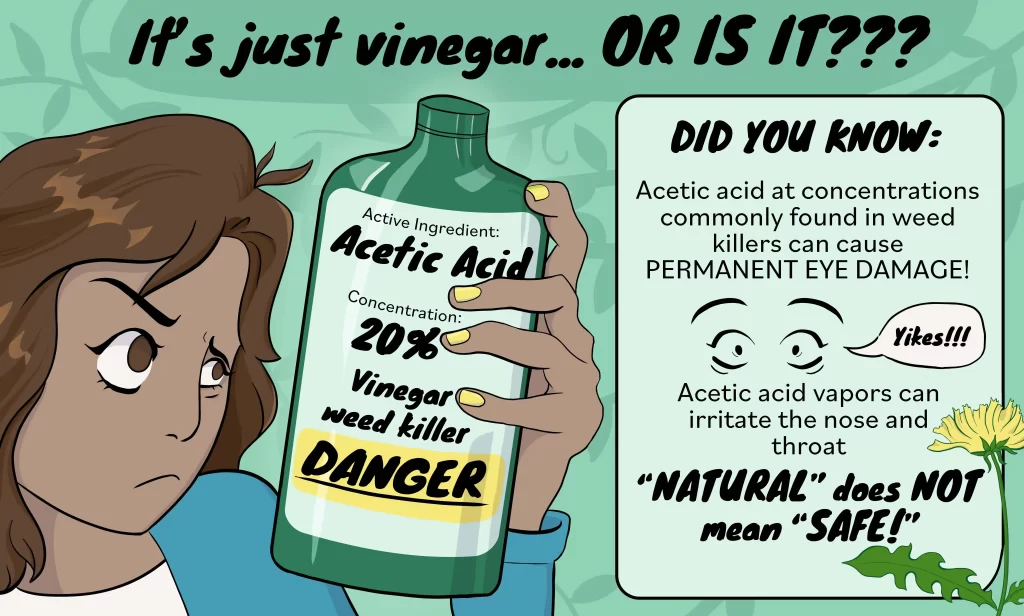
Vinegar Weed Killer Alternatives & Enhancements
- Horticultural Vinegar for Tough Weeds: 20–30% acetic acid solutions deliver deeper burn, effective on hardier perennials, but require careful handling and protective gear.
- Combined Strategies:
- Manual weeding and mulching alongside vinegar sprays can suppress regrowth and reduce seed germination.
- Boiling water or salt barriers (e.g., salt lines in cracks) can complement vinegar treatments on patios and driveways.
- Natural Additives:
- Lemon juice adds extra acidity and a pleasant scent.
- Essential oils (e.g., clove or cinnamon) have phytotoxic properties and can boost the recipe’s efficacy.
Environmental & Safety Considerations of Vinegar Weed Killer
- Limit application near water bodies to prevent pH shifts that can impact aquatic organisms.
- Monitor soil pH if using vinegar regularly, and amend with lime if necessary to restore balance.
- Spray only target weeds to avoid harming pollinators feeding on nectar.
- Allow treated areas to dry fully before reintroducing pets or wildlife.
Long-Term Weed Management
While vinegar weed killer can scorch foliage effectively, its inherent limitations mean it should not be relied upon as the sole strategy for long-term weed suppression. As horticultural consultant Eva Reutinger emphasizes, an integrated approach combining hand pulling, organic herbicides, and strategic plant selections produces more durable control than any single tactic. Incorporating ground covers such as creeping thyme or clover not only crowds out weeds but also stabilizes soil, while generous layers of organic mulch create a physical barrier that inhibits seed germination and conserves moisture.
Early-season cover cropping with species like cereal rye or buckwheat further disrupts weed lifecycles by outcompeting seedlings and depleting the soil seedbank before weeds can establish. Because household-strength vinegar lacks systemic activity, spot treatments must be repeated, and gardeners should be wary of soil pH shifts if it’s overused in beds of sensitive plants. By weaving together these cultural, mechanical, and organic tactics, landscapers can construct resilient plant communities that suppress weeds sustainably rather than depending solely on acetic acid’s contact action.
That’s It!
DIY Vinegar weed killer offers a natural, non-toxic way to tackle unwanted plants, making it a handy tool in any eco-conscious gardener’s arsenal. But as we’ve explored, real and lasting weed control comes from working smarter—not harder—with a mix of well-timed vinegar treatments, thoughtful planting choices, ground covers, mulching, and consistent garden care. By embracing this layered approach, you’ll not only reduce your weed problems but also build healthier, more resilient garden beds over time. So, reach for that spray bottle when you need a quick fix, but don’t forget to invest in the long game—because a balanced, thriving garden is the best defense against weeds.
Ready to reclaim your garden, naturally? Your weed-free oasis starts here. Give this natural solution a try—and let us know how your garden thrives!
Frequently Asked Questions
Does vinegar weed killer affect the soil?
Vinegar is primarily a contact herbicide and doesn’t persist in the soil long-term. However, repeated heavy use, especially of horticultural-strength vinegar, can temporarily lower soil pH and harm beneficial soil microbes. It’s best to use vinegar sparingly and target only the weeds, not the surrounding soil.
Will vinegar kill grass along with weeds?
Yes, vinegar is non-selective, meaning it will damage or kill any plant it touches, including grass. If you’re treating weeds in your lawn, be extremely cautious or use a shield to protect the grass you want to keep.
Can I mix vinegar with salt and dish soap for better results?
Many homemade weed killer recipes combine vinegar with salt and a few drops of dish soap. Salt can improve effectiveness by dehydrating plants further, and dish soap helps the solution stick to leaves.
How long does it take for vinegar to kill weeds?
You may see weeds start to wilt within hours of application on a sunny day, with full dieback typically occurring within 24 hours. Tougher, perennial weeds may need repeated applications over several days.
Can I use vinegar weed killer in vegetable gardens?
Vinegar can be used carefully in vegetable gardens, but avoid spraying near edible plants. It will harm vegetables just as easily as it kills weeds. For garden paths or areas between raised beds, it can be an effective natural solution.
What’s the difference between household vinegar and horticultural vinegar?
Household vinegar contains about 5% acetic acid, while horticultural vinegar ranges from 10% to 20% or more. The stronger the concentration, the faster and more effective it is at killing weeds — but it also poses more risk to skin, eyes, and soil health, and requires protective gear during application.



